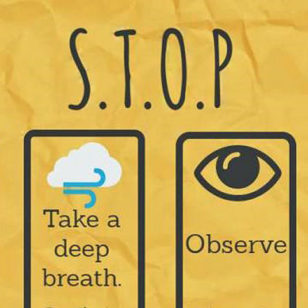You Are The Sky
How mindfulness and meditation can help you find balance and authenticity.
Anyone who has flown above the clouds knows that the sun is always shining up there, the sky is clear and warm, no matter what is going on below. With the stress of daily life, our thoughts become the clouds that turn our sky grey and cast shadows on our experience. If we identify ourselves only with those thoughts, we tend to let them rule our being. Our own virtual reality becomes “our story” that we willfully share with anyone who will listen and build up to justify our feelings or opinions. Over time, this “story” can become hardened and difficult to change since our neurons communicate the same messages over and over (you know, the typical grumpy old man) (Tolle, 2006). Neuroscientists say that “neurons that fire together, wire together”. This can work to our advantage or our disadvantage, as we end up identifying ourselves with the image we have created through the repetition of our own thoughts and beliefs; and this can affect our daily lives, our health and our overall wellbeing (Siegel, 2010).
Fortunately, scientists have now proven that our brains are actually “malleable”. This is called neuroplasticity. I won’t go too deeply into this, since you can “Google” the term and find a wealth of information. The main idea is that our brains can change, and at any age. We can make new neural connections and literally change the messages our brains are sending to our bodies and minds. This means that we don’t have to be victims of our thoughts, our circumstances or anyone else’s. The most beautiful thing of all is that each and every one of us can change our brains, without much other than a place to sit and the will to exercise your mind. This is through meditation and mindfulness. It is free, relaxing, healthy and it can change your life.

What is Meditation?
It is one in the morning and you go to bed with the endless thought motor running. Then, at some point we fall asleep to a prelude of past and future excitement, worry, illusion, guilt, fear, resentment, stress… and when we wake up, there it is again, waiting for us like a loyal friend, or more like a pimple, ready to accompany us throughout our day, often adding stress and discontentment, and certainly keeping us from being in the present moment.
Meditation is your ticket out of this dynamic and into a more balanced mental existence; into life in the now.
Imagine that you could take all of that mental chatter, particularly the negative or stressful messages, and crumple it up into a ball in your hands, seeing it from a distance, and call it by its true name: a ball of “thoughts”; and then just let it fall away without judgment. Meditation is a technique to help you do this. If you can recognize your thoughts as something separate from yourself, then that means that you are not your thoughts. If you are not your thoughts, then they do not define you, and therefore do not control you.
This is particularly interesting with any very damaging thoughts of mass destruction that cause suffering in our lives. If you can recognize your thoughts and label them, you start putting them into consciousness and allow yourself the space to see them for what they are, just thoughts. Within that space, we then have an opportunity to respond instead of react, to catch our automatic thinking patterns in the moment and decide where we go from there. This is how you start changing those connections in your brain.
With meditation, you can learn simple exercises to recognize each thought (the cloud) for what it is, acknowledge it, let it go and return back to your true essence (the sky), which is pure beauty and beyond any limits of verbal definition. Letting those thoughts float by, without getting involved in them, allows you to avoid being carried away and to stop the pattern that is forming these negative connections. This is a repetitive exercise, recognizing the thought for what it is by labelling it, letting it go and then going back to a constant objective focus (normally your own breath). Soon the thoughts lessen and silence grows and you are able to see clearly, like when dirt settles to the bottom of a pond and you can finally see to the bottom. Meditation teaches you to be present, allows you the clarity to find your true self and to have an expanded vision of the world around you.
What is happening, then, physiologically? One effect of meditation is that it helps create new connections in your brain. These are healthier connections that “wire together” and help keep your sympathetic nervous system in check. The sympathetic nervous system controls our reaction to fear or stress, and puts us into a “fight” mode or a “flight” mode. This is great when we are about to be run over by a bus, but not so great when it is set off by something trivial or minor, for example, causing us to lash out at someone who “offends” us or stutter and freeze up while giving a speech. Meditation helps you and your brain become conscious and aware of the difference between real fear (which is necessary to keep us out of danger) and an exaggerated fearful response to something that is not truly life threatening. Over time, this results in a more equanimous state of mind in which life’s ups and downs, great or small, each have their own balanced response (Siegel, 2010).
What is mindfulness?
Mindfulness includes two types of practices: the formal practice of meditation and the informal practice in which we activate our awareness in a specific way in everyday situations. In the daily informal practice, our attention is placed on our thoughts, emotions and on the body in the present moment. The observer we all have inside us is activated, bringing into awareness not only what is happening in that moment but also the thoughts, emotions and bodily sensations that arise. As we practice, we begin to recognize the automatic reactions we have, which often stem from fears, learned behaviors or insecurities. We can learn a lot about ourselves and even discover the some of the underlying causes of our own unhappiness in these reactions. This awareness of what is going on outside of us and inside of us creates a space which allows us to see a more realistic picture and to choose our response to the situation rather than be a victim of our automatic reactions.
This space created and our ability to choose our responses to our life events provide the opportunity for us to live an authentic existence where our true essence can emerge. This is just the tip of the iceberg. Both meditation and mindfulness bring about compassion, kindness, equanimity, release of the egoic mind, improved immune system, reduced stress and many more enriching effects.
Practicing meditation even just 10 minutes per day can change your mind and your life. Physically you will create new connections in your brain and enhance your ability to discern what is real, and what is just a story we are creating about reality. Emotionally, you will find more balance and stress reduction. You will start to notice that your reactions to life’s daily happenings have become chosen responses. Daily informal mindfulness practice brings new light to old behaviors and situations. You may even feel like you see others and their reactions to things in a completely different way, recognizing then, when you or they are letting their “story” take control.
After some time meditating, you start to realize that you are the sky and no matter what the weather down below, you remain a peaceful unaltered witness.
Bibliography
Siegel, Daniel J. The Developing Mind: How Relationships and the Brain Interact to Shape Who We Are. New York: Guilford, 1999. Print.
Siegel, Daniel J. Mindsight: The New Science of Personal Transformation. New York: Bantam, 2010. Print.
Tolle, Eckhart. A New Earth: Awakening to Your Life’s Purpose. New York: Plume, 2006. Print.



